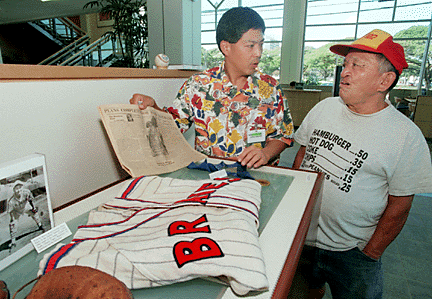


Moiliili bank’s
motif a tribute to
Honolulu Stadium
The bank, across from where
By Rod Ohira
the stadium once stood, stirs
nostalgia with its mementos
Star-BulletinHONOLULU Stadium, a Moiliili landmark that was torn down in 1976, is the inspiration for the motif of First Hawaiian's new University Bank Center.
The clean-lined, two-story bank sits on the former location of Chunky's Drive-In, across Isenberg Street from the old ballpark site.
The building's glass walls feature etchings of the ballpark's baseball infield framed by football goalposts, and inside are two display cases with Honolulu Stadium memorabilia.
Walter Dods, chairman of the board and chief executive officer of First Hawaiian Bank, says public response has been positive.
"People like the building, especially the way it lights up at night," Dods said. "I have a lot of fond memories of Honolulu Stadium and of playing softball across the street at Moiliili Field.
"The Moiliili area had gotten run down in recent years and we wanted to try and set an example. I think the building reflects the proud tradition of Honolulu Stadium."
Arthur Suehiro, a First Hawaiian account review officer and author of "Honolulu Stadium -- Where Hawaii Played," hustled the items on display, which includes an official 7th Army Air Force baseball autographed by Joe DiMaggio.
DiMaggio homered while playing for the 7th Army team in a June 1944 game at the stadium, which drew more than 30,000 fans.
Other memorabilia include a 20-cent program from the Hawaii Islanders' inaugural 1961 Pacific Coast League baseball season, and a ball marking Hawaii's membership in the World Football League's only year of play, in 1975.
Kauai artist Carol Bennett, working from original photos that appeared in Suehiro's book, painted several large murals paying tribute to Elvis Presley's concert at the stadium, and fan favorite "Cherry Nose" Neves' stock-car racing exploits there.
There's also a painted view of the left-field bleachers with the Melim tire scoreboard clock, whose second hand, sportscaster Jimmy Leahey often remarked, went from 12 to 6 faster than from 6 to 12.
"It fell faster because of gravity but had to struggle back up, so it came out to be a minute," Leahey said.
Memorabilia spawns conversations, and the bank is doing its part to keep 50 years of Honolulu Stadium memories alive.
"I used to watch high school games at the old stadium mostly every Friday after work," said Richard Kurata, 77, a Kapahulu resident and regular bank customer.
"I've never been to the new stadium (in Halawa)," he said. "I come to the bank often but I never noticed (the displays) before.
"It's really nice of them to do this."
In the glory days of prep football at the old stadium, nothing symbolized the intense rivalry in the Interscholastic League of Honolulu more than the painting raids staged by Roosevelt and Punahou.
The "Paint Brush Trophy," on loan from Punahou School, has been part of the stadium display since the bank opened last May but will be returned next month, Suehiro said.
Mike Topolinski, a 1941 Roosevelt graduate and football-letter man, remembers the painting raids that fueled the rivalry with Punahou.
"It started around 1939 when they came to our campus and painted the football field in Punahou colors," said Topolinski, 77. "In '41, someone put up a Roosevelt flag at Punahou and cut the rope on the flagpole.
"They had to hire a steeplejack to get it down. It just went on from there."
Another year, red paint was tossed into Punahou's swimming pool.
To tone down acts of vandalism, the two schools established the "Paint Brush Trophy" in 1948, which they vied for 22 times through 1969, when the rivalry ended with the breakup of the old ILH.
"It was an attempt to make the rivalry stand for something other than vandalism," said Dave Eldredge, who played, coached and taught at Punahou.
"Since paint brushes were the major thing, we decided to use it for the trophy, he said."
Eldredge and Star-Bulletin columnist Ben Wood, who was Roosevelt's quarterback, played in the first "Paint Brush" game in 1948, won by Punahou 13-10.
Years later, Eldredge saved the "Paint Brush" from the rubbish heap during an athletic facility cleanup and kept it at home until his recent retirement, when he gave it back to the school.
On permanent display is the Roosevelt High football jersey worn by the late John Bellinger, First Hawaiian Bank's chief executive officer, and the Hawaiian Commercial & Businessman's Athletic Association trophy cup awarded to him in 1940 as the ILH's most outstanding player.
Another interesting exhibit item is the "Poi Pounder," a trophy established during World War II when St. Louis School and McKinley became rivals while sharing the same campus.
St. Louis held classes at McKinley while its campus served as a military hospital.